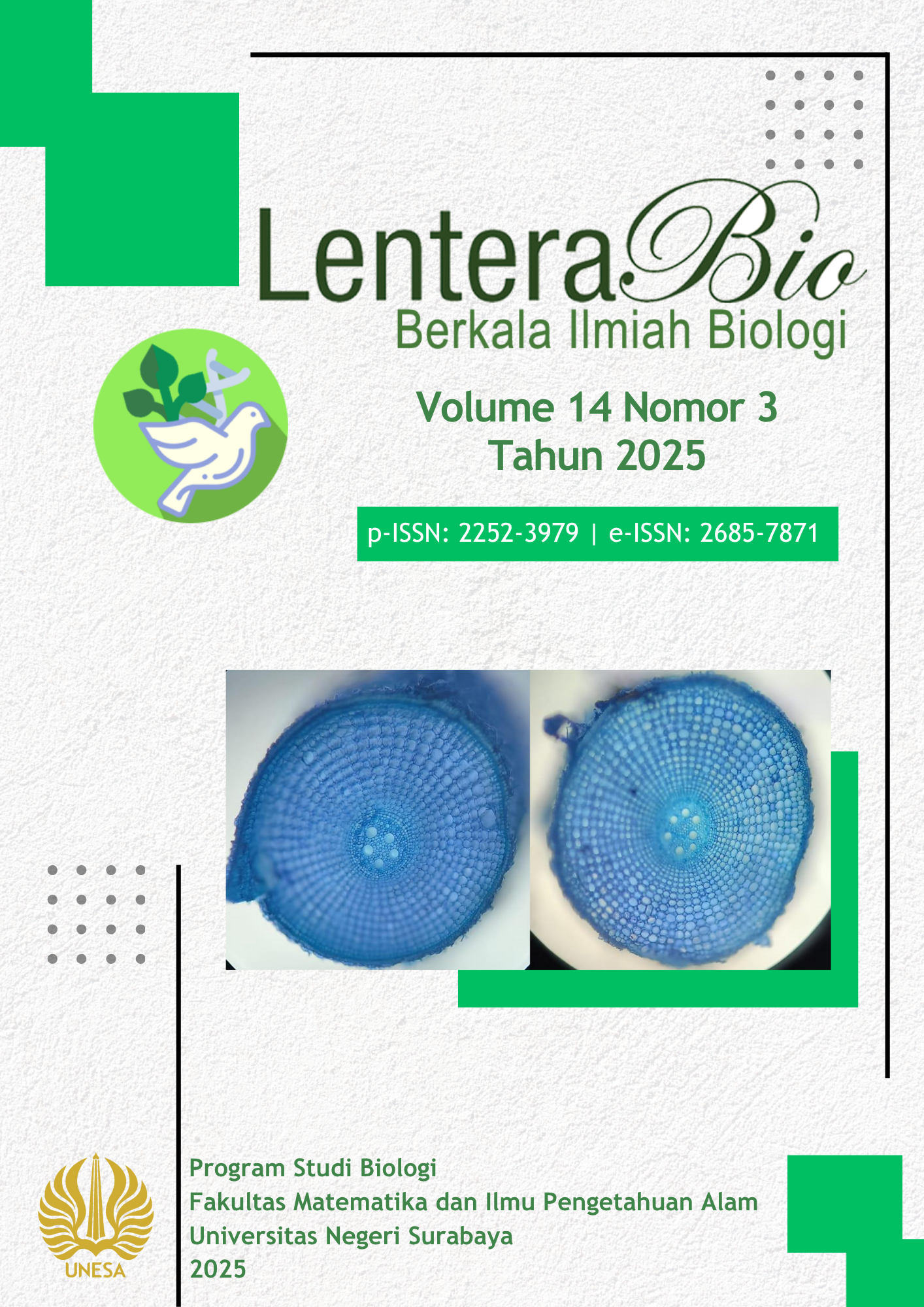The Capability of Water Spinach (Ipomoea aquatica) as Phytoremediator of Heavy Metal Chromium (Cr)
DOI:
https://doi.org/10.26740/lenterabio.v14n3.p374-379Keywords:
ANOVA, growth medium, metal absorption, water pollutionAbstract
In the current era of globalization, humans are involved in various industrial and household activities with high intensity, which leads to water pollution in rivers. This water pollution is caused by the discharge of waste from industries and household waste containing chromium (Cr). To prevent the harmful effects of chromium, it can be addressed through phytoremediation methods. Consequently, the purpose of this investigation is to illustrate the potential of water spinach (Ipomoea aquatica) as a phytoremediation species capable of lowering chromium (Cr) concentrations in the cultivation medium. This trial was arranged under a randomized block design (RBD) involving a single treatment variable, namely the chromium (Cr) concentration within the medium at 0 ppm, 5 ppm, 10 ppm, and 15 ppm. Evaluation of chromium content, foliar chlorophyll levels, and fresh biomass was carried out through a one-way ANOVA followed by Duncan’s multiple range test. The treatment with 15 ppm chromium demonstrated a decrease of 11.853 ppm in the medium, yet it yielded the lowest chlorophyll value and the greatest reduction in biomass compared to the other treatments, reaching 10.167 mg/l and 142 grams, respectively, from an initial mass of 200 grams. A correlation coefficient of 0.796 was also identified, signifying a strong association between leaf chlorophyll concentration and the final fresh biomass of water spinach (Ipomoea aquatica). These outcomes confirm that Ipomoea aquatica possesses the capacity to uptake chromium (Cr).
References
Agusetyadevy I, Sumiyati S, and Sutrisno E, 2013. Fitoremediasi limbah yang mengandung Timbal (Pb) dan Kromium (Cr) dengan menggunakan kangkung air (Ipomoea aquatica). Jurnal Teknik Lingkungan, 2(2): 1-9.
Al-Ajalin FAH, Abdullah SRS, Idris M, Kurniawan SB, Ramli NN, and Imron MF, 2022. Removal of ammonium, phosphate, and COD by bacteria isolated from Lepironia articulata and Scirpus grossus root system. International Journal of Environmental Science and Technology, 19(12): 11893-11904.
Alvarez CC, Gómez MEB, and Zavala AH, 2021. Hexavalent chromium: Regulation and health effects. Journal of trace elements in medicine and biology, 65: 126729.
Ali H, Khan E, and Sajad MA, 2013. Phytoremediation of heavy metals concepts and applications. Chemosphere, 91(7) : 869-881.
Darmono, 2008. Lingkungan Hidup dan Pencemaran. Penerbit Universitas Indonesia, Jakarta. 69.
Dewi F and Faisal M, 2015. Efisiensi penyerapan phospat limbah laundry menggunakan kangkung air (Ipomoea aquatic Forsk) dan jeringau (Acorus calamus). Jurnal Teknik Kimia USU, 4(1) : 7-10. DOI: https://doi.org/10.32734/jtk.v4i1.1452.
He L, Wang S, Liu M, Chen Z, Xu J, and Dong Y, 2023. Transport and transformation of atmospheric metals in ecosystems: A review. Journal of Hazardous Materials Advances, 9: 100218.
Hidayati N, 2013. Mekanisme fisiologis tumbuhan hiperakumulator logam berat. Jurnal Teknik Lingkungan, 14(2) : 75-82
Irhamni I, Pandia S, Purba E, and Hasan W, 2017. Kajian akumulator beberapa tumbuhan air dalam menyerap logam berat secara fitoremediasi. Jurnal Serambi Engineering, 1(2): 75-84.
Izzah I, Supriatno S, and Wardiah W, 2018. Kiambang (Pistia stratiotes) sebagai agen fitoremediasi logam krom (Cr). In Prosiding Seminar Nasional Biotik, 5(1): 324-330.
Juhri DA, 2017. Pengaruh Logam Berat (Kadmium, Kromium, dan Timbal) terhadap Penurunan Berat Basah Kangkung Air (Ipomoea aquatica Forsk) sebagai Bahan Penyuluhan Bagi Petani Sayur. Jurnal Lentera Pendidikan Pusat Penelitian LPPM UM Metro, 2(2): 219-229.
Kasmiyati S, 2014. Deteksi Cekaman Oksidatif Akibat Tokksisitas Krom Pada Sonchus Oleraceus L. Melalui Penentuan Spesies Oksigen Reaktif Secara Spektrofotometri dan Histokimia. Agric, 26(1): 85-98.
Lestari A, Anita S, and Hanifah TA, 2015. Potensi Tanaman Genjer (Limnocharis flava) Sebagai Fitoremediator Ion Kadmium (II), Kromium (IV) dan Timbal (II). JOM FMIPA Universitas Riau. 2(2): 1-7
Panda S, Sahoo L, and Mohapatra PK, 2005. Chromium-induced changes in enzyme activities and structural alterations in chloroplasts and cell membranes of plants. Journal of Environmental Science and Health, Part A, 40(5): 789-802
Paz-Alberto AM and Sigua GC, 2013. Phytoremediation: a green technology to remove environmental pollutants. American journal of climate change, 2(1): 71-86.
Putri LRID, Moelyaningrum AD, and Ningrum PTR, 2022. Kondisi Fisik Air Sungai Dan Kandungan Logam Kromium Pada Ikan Nila (Oreochromis niloticus)(Studi Di Sungai Kreongan Sekitar Industri Batik X, Kecamatan Patrang, Kabupaten Jember). Jurnal Kesehatan Lingkungan Indonesia, 21(3): 293-300.
Rahmadiah and Rachmaniyah, 2020. Fitoremediasi Tanaman Kangkung Air (Ipomea aquatica ) dalam Menurunkan Kadar Timbal (Pb) pada Air Sumur. Poltekkes Kemenkes. Surabaya.
Reddy MV, Subrahmanyam D, and Singh AK, 2013. Phytoremediation: An overview. Critical Reviews in Environmental Science and Technology, 43(13): 1311- 1355
Rosyidah NF and Rachmadiarti F, 2023. Salvinia molesta sebagai Agen Fitoremediasi Logam Berat Zink (Zn) di Perairan. LenteraBio: Berkala Ilmiah Biologi, 12(3): 430- 438.
Sugihartono S, 2016. Pemisahan krom pada limbah cair industri penyamakan kulit menggunakan gelatin dan flokulan anorganik. Journal of Leather, Rubber, and Plastics, 32(1): 21-30.
Surakusumah W, Nilawati T, and Khairunisa R, 2020. Potensi Alocasia macrorhiza Sebagai Fitoremediator Logam Kromium. Jurnal Ilmu Alam dan Lingkungan, 11(2): 8-14.
Umar YP, Anugroho F, and Tahir U, 2023. Perbandingan Kangkung Air (Ipomoea Aquatica Forck) dan Mikroorganisme Dalam Upaya Menurunkan Logam Kromium hexavalent (Cr (VI)) pada Air Sungai. Jurnal Sumberdaya Alam dan Lingkungan, 10(1): 42-48.
Weerasinghe A, Ariyawnasa S, and Weerasooriya R, 2008. Phyto-remediation potential of Ipomoea aquatica for Cr (VI) mitigation. Chemosphere, 70(3): 521-524.
Yuliasni R, Kurniawan SB, Marlena B, Hidayat MR, Kadier A, and Ma PC, 2023. Recent progress of phytoremediation-based technologies for industrial wastewater treatment. Phycoremediation Processes in Industrial Wastewater Treatment, 21-41.
Downloads
Published
How to Cite
Issue
Section
License
Copyright (c) 2025 LenteraBio : Berkala Ilmiah Biologi

This work is licensed under a Creative Commons Attribution-NonCommercial 4.0 International License.
Hak Cipta (c) LenteraBio: Berkala Ilmiah Biologi
Karya ini dilisensikan di bawah Lisensi Internasional Creative Commons Attribution-NonCommercial 4.0.
Pemberitahuan Hak Cipta.
Hak cipta dari artikel yang diterima untuk diterbitkan akan diberikan kepada jurnal sebagai penerbit jurnal. Hak cipta yang dimaksud meliputi hak untuk menerbitkan artikel dalam berbagai bentuk (termasuk cetak ulang). Jurnal mempertahankan hak penerbitan atas artikel yang diterbitkan.
 Abstract views: 186
,
Abstract views: 186
, PDF Downloads: 116
PDF Downloads: 116











